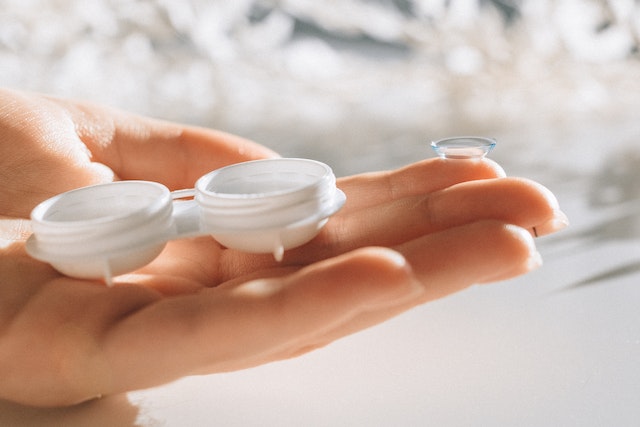
What are contact lenses made of? Soft contact lenses are made of an oxygen permeable soft plastic. Hard lenses are made of a plastic like Perspex.
There are generally two types of contact lenses: soft and hard. Soft lenses are made of a soft plastic. These days, the plastic used is silicone hydrogel. Silicone hydrogel is a flexible plastic that is very permeable to oxygen. It is extremely important to make sure that contact lenses are permeable to oxygen because the cornea in the eye doesn’t have blood vessels and consequently no oxygen supply. The oxygen comes from the air and the tears. If contact lenses are not permeable to oxygen, it can be very harmful to the eyes. Your cornea can build up lactic acid and even change shape.
Silicone hydrogel lenses came on the market in 1998 and they last much longer than previous lenses. The structure of the silicone leaves “holes” that the oxygen can pass through. Some lenses are so permeable that they can be worn for twenty-four hours. However, they are not perfect. Silicone hydrogel is a hydrophobic material. Putting something in your wet eye that is hydrophobic can be uncomfortable. It is also difficult to wash and clean them. To avoid this, the lenses are treated with a hydrophilic plasma coating that solves the problem.
There are two types of materials with respect to water: hydrophobic and hydrophilic. Hydrophobic materials repel water. The molecules within something that is hydrophobic repel water molecules because their molecules don’t have a positive or a negative charge. The charges of the molecule are evenly distributed across the molecule, so it isn’t positive or negative. Water molecules have a positive and a negative charge, so they are attracted to molecules that have a positive or negative charge, meaning they are not attracted to hydrophobic molecules. Oil is a hydrophobic substance, which is why it doesn’t mix with water. Hydrophilic molecules do have a charge and attract water molecules.
Hard lenses are made from a plastic called polymethyl methacrylate, more commonly known as Perspex or plexiglass. This plastic is great for keeping the shape, but it is not permeable to oxygen. To solve this problem, fluorine is added during the manufacturing process. The fluorine creates microscopic pores in the plastic that oxygen can flow through. Hard lenses are better than soft lenses for correcting defects in the shape of the eye, they last longer, are more durable, and cause less deposit build up in the eye, but they are more uncomfortable and take longer to get used to.
The first “contact lens” was made in 1801 by Thomas Young. He worked with an idea thought up by Descartes, who was a scientist as well as a philosopher. He used wax to fit water-filled lenses to his eyes. It improved his version, but it sounds very painful. A good example of the way scientists and experimenters would use themselves as guinea pigs.
Louis J Girard made a more practical lens in 1887, but it was, of course, made of glass. A German ophthalmologist, Adolf Gaston Eugen Fick, tested it on rabbits, himself, and volunteers. It worked, but it was painful and couldn’t be worn for more than a few hours at a time.
The invention of plastic, especially soft plastic, led the way for practical contact lenses in the 1930s. In 1949, a smaller lens was created when someone realized a lens only needed to cover the cornea and not the whole eye. However, none of these lenses let oxygen pass through to the eye, causing a lot of eye problems. It wasn’t until 1965, after the discovery that hydrophilic gels let oxygen pass through, that modern-style contact lenses were introduced.
There is quite a lot of research going into smart lenses at the moment. One prototype squeezes 100,000 LEDs into a 0.41 mm space. These LEDs project a screen that only the user can see. They could be used for magnification, for displaying information, and for correcting other eye problems. Who knows what will happen in the future? Maybe I will have bionic smart lenses in my eyes.
So, hard and soft lenses are made of different materials, but they are both oxygen permeable. And this is what I learned today.
Sources
https://contactlensupdate.com/2021/06/15/contact-lens-technologies-of-the-future
https://en.wikipedia.org/wiki/Contact_lens
https://www.thoughtco.com/definition-of-nonpolar-molecule-604582
https://www.thoughtco.com/what-are-contact-lenses-made-of-4117551
https://www.fda.gov/medical-devices/contact-lenses/types-contact-lenses
